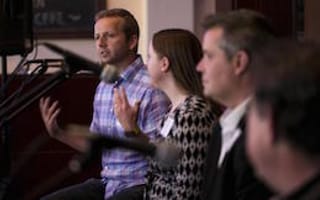[ibimage==34367==Large==none==self==ibimage_align-center]
Rustin Banks, Ingrid Alongi, Finn Faldi, Howard Diamond (right)
Seven years ago, the Colorado tech industry was in its teenage years. Brilliant minds were collaborating on how to take advantage of the new age of technology and as more social media players arrived in the field, the startup age was ripe for explosion. Twitter was gaining traction, app design and mobile optimization were in high demand, and personalized online advertising was evolving.
Those with coding backgrounds were especially primed to take advantage of the emerging market. Still, few startups are fortunate enough to have technical founders at their helm.
TapInfluence co-founder Rustin Banks, a self identified ‘closet-coder’ in his youth, and Quick Left co-founder Ingrid Alongi, an engineer by trade, are two of the lucky ones. Both took over both the CEO and a technical role at their companies and found themselves still leading those startups a decade later.
On June 15, 100 of the top technology leaders in Colorado gathered to hear about the evolution of their evolution. The panel, sponsored by CBRE, was comprised of three former CEOs — Finn Faldi (Chairman of Trueffect Advisory Board), Ingrid Alongi (Chief People Officer, Quick Left), and Rustin Banks (CPO of TapInfluence). The panel was moderated by Howard Diamond, CEO of MobileDay, who has had extensive experience in leading companies into the next stage of growth.
Here are our top takeaways from on how and why they successfully made the transition out of the founding CEO role.
“I never came into the company with the idea of being the CEO.”
Often, founders move into the CEO role without knowingly assuming the post for the longterm. At the time, it makes sense. But ultimately, it may not be the best place for the founder — managerial duties take time over skilled trade roles and it's hard to take a step back and look at company structure.
As Faldi noted, “The founder is the connective tissue in the organization. You can’t just make that up. Typically they take a lesser day-to-day role and more of a cultural post.”
Check yourself to avoid burn out and the “toxicity” it creates
Being CEO takes a certain level of attention and a certain amount of energy. People are constantly trying to read you and follow your lead and you (and anyone else) who are burned out have a negative effect on the cultural environment.
Pulling back and analyzing who is best to lead you through the next phase is hard to do, but may save major issues down the line.
Novelty imparts excitement.
Diamond emphasized the importance of change, “It’s healthy for companies and people to transition into new roles in order to reenergize.“
It's important to encourage fresh ideas and movement within the organization so employees don't get too comfortable. A new energetic face does wonders to morale.
Transitions shouldn't imply the negative
Role transitions are not specific to when something is wrong internally, transitions also happen after an acquisition, when it’s time to reach a new level of growth, and when something is going awry.
In the end, a lot of it comes down to ego. Banishing the ego’s arguments before and after ensures that one isn’t blind to a necessary change and that she is able to make the most of it.






